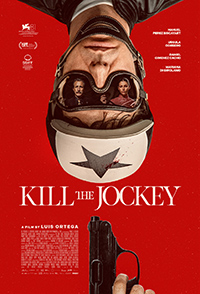They Kill Horse Riders, Don’t They?: Ortega Puzzles with Deadpan Metaphors
 Nothing is what it appears to be in Argentinean Luis Ortega’s latest film Kill the Jockey, a crime comedy drama which becomes an increasingly complex exercise regarding identity. The film itself suffers from the same semblance of identity crisis as some of its characters, which is akin to Ortega’s last film, El Angel (2018), about a cherub-faced criminal whose misdeeds initially seem all the more shocking because of his demeanor. Nahuel Pérez Biscayart leads the charge in what partially appears to be a trans allegory with a sometimes convoluted, sometimes amusing mixture of rebirth/reincarnation themes which might be overtly perplexing on a first view but most assuredly will reveal more complex interpretations upon closer examination. Fans of Kafka or Anna Kavan might rejoice in its droll horrors of slippery insinuations, particularly with a pronouncedly enjoyable first act and a delirious mad rush in the climax.
Nothing is what it appears to be in Argentinean Luis Ortega’s latest film Kill the Jockey, a crime comedy drama which becomes an increasingly complex exercise regarding identity. The film itself suffers from the same semblance of identity crisis as some of its characters, which is akin to Ortega’s last film, El Angel (2018), about a cherub-faced criminal whose misdeeds initially seem all the more shocking because of his demeanor. Nahuel Pérez Biscayart leads the charge in what partially appears to be a trans allegory with a sometimes convoluted, sometimes amusing mixture of rebirth/reincarnation themes which might be overtly perplexing on a first view but most assuredly will reveal more complex interpretations upon closer examination. Fans of Kafka or Anna Kavan might rejoice in its droll horrors of slippery insinuations, particularly with a pronouncedly enjoyable first act and a delirious mad rush in the climax.
Remo (Biscayart) is a celebrated jockey who works for criminal kingpin Sirena (Daniel Jimenez Cacho). His girlfriend Abril (Úrsula Corberó) is equally talented but less celebrated, her pregnancy suggesting her days competing against him are limited. But the glaring issue at the moment is Remo’s unwillingness to remain sober, compromising his most recent races with liquor and ketamine. Sirena locks him up in the stables for the upcoming Grand Prix. But Remo manages to derail this race as well, leading to an accident where he’s hospitalized. Escaping before Sirena can collect him, Remo wanders the streets in women’s garb, and slowly seems to be changing.
“Misfortune is the best school,” remarks one of the goons responsible for overseeing Remo, a young man who we’re told has come from unfortunate circumstances and was eventually saved by mob boss Sirena. He’s indefinitely indebted to the under lord, but it would seem he’s hellbent on sabotaging this relationship for reasons which initially seem unclear. Ortega gives us hints rather than exposition that leads us towards certain interpretations about what happened and what’s going on, though these are unveiled in mystical, obscure stories. It would seem Remo was an underground jockey named Delores, who ran into trouble making money betting against himself. There’s also a mysterious figure (who looks a lot like Vincent Lindon) who states he was sent by God, potentially a guardian angel figure arriving during what seems to be the film’s first real transitional moment.
What’s unfortunate about all this shifting and twisting, at least tonally, is how the first act of Kill the Jockey feels like an exceptionally offbeat comedy, reminiscent of Aki Kaurismaki with one helluva fantastic Lanthimos-like dance sequence. The weirdness congeals in the gender role reversal of both Abril and Remo, who are expecting a child she doesn’t seem interested in carrying to term. In the midst of his drug induced stupors, Remo asks what he would need to do to earn her love again, to which Abril replies “Die and be born again.” It would seem this is something which metaphorically transpires later in the film. At the same time, Sirena always has an infant in tow, a fixture one character remarks never ages, though it would seem he intermittently changes infants, and admits he desires to take Abril’s.
But then the film switches up after Remo blows the Grand Prix in what seems to be an intentional accident on a horse named Mishima (which seems an appropriate name as any if we’re taking into account the ritual suicide of queer writer Yukio Mishima). Remo, bandaged like he’s hiding a Marge Simpson beehive, absconds with a woman’s fur coat and belongings from the hospital as Sirena’s men attempt to track him down. Meanwhile, Abril begins an intimate affair with Ana (Mariana Di Girolamo), another jockey. In his wanderings, Remo begins to take on more feminine aspects, mistaken for a woman on the streets by a quartet of reappearing vagabond children. Finally arrested after a violent confrontation with Sirena and his henchmen, Remo becomes Lola while in prison, a hairdresser who seems to have finally found herself. Until the warden (Roly Serrano) offers Lola the chance to become Remo again as a means to periodically get out of prison.
While these subtexts are interesting, switching into what feels like an early Almodovar title, Kill the Jockey also drags considerably when it diverts into a lackadaisical cat and mouse exercise. Ortega then seems to click themes back into place when Lola makes her first appearance, with Biscayart resembling Ida Lupino. Abril helps us understand Lola is actually the aforementioned Delores, and this is likely the identity Remo always desired, which explains his move toward self-annihilation.
Playing like a magical realism allegory on gender expression, Kill the Jockey aggravates as much as it provokes. But undoubtedly, it strikes its own pose, and it doesn’t matter who’s a boy or a girl.
Reviewed on August 29th at the 2024 Venice Film Festival (81st edition) – In Competition section. 97 Minutes.
★★★/☆☆☆☆☆


